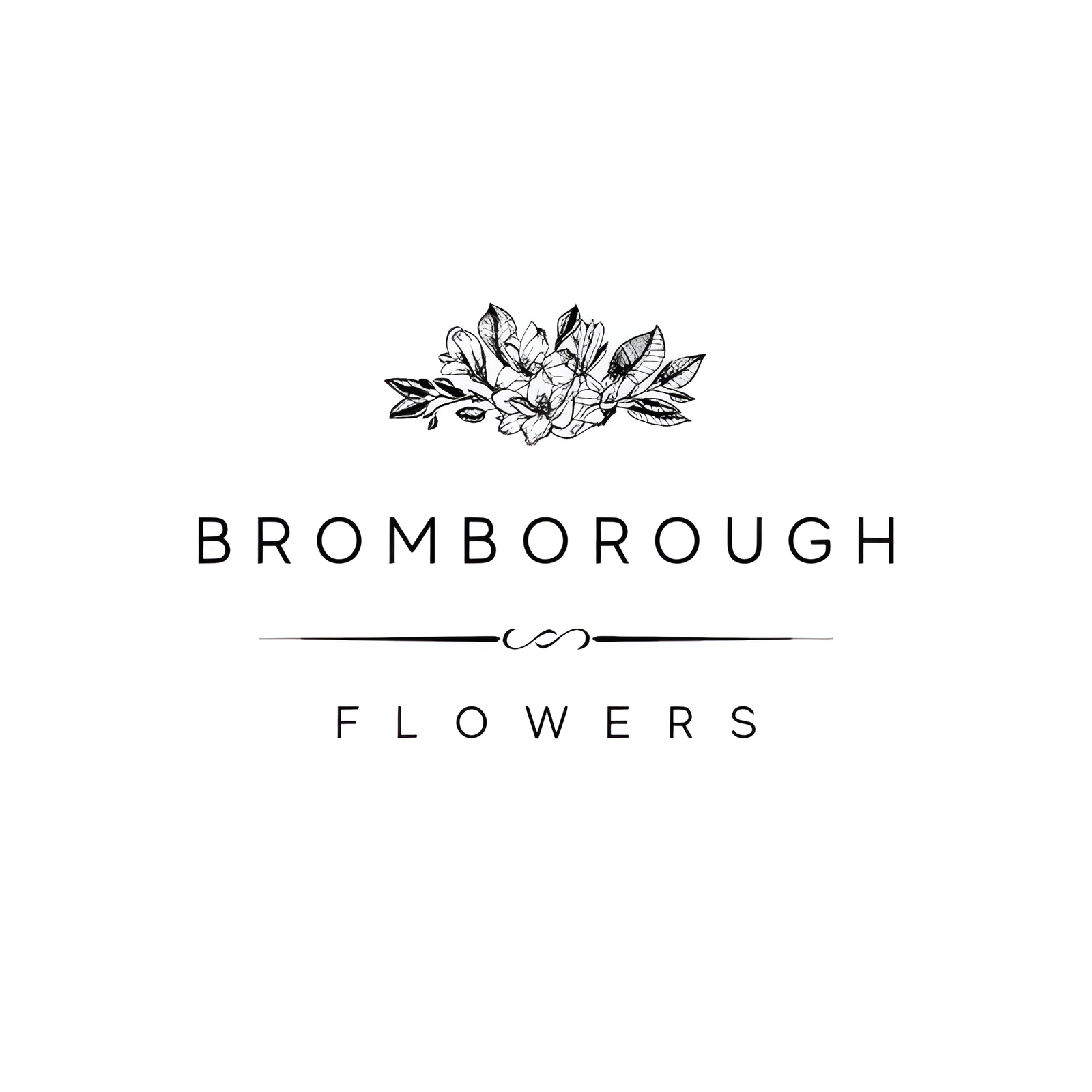The Dogwood flower, renowned for its graceful clusters of white, pink, or light red blossoms, stands as an elegant addition to wedding decor. Symbolizing faithfulness and endurance, this versatile bloom offers a subtle yet profound touch to any matrimonial celebration. Given its status as the state flower of North Carolina and Virginia, the Dogwood carries significant cultural weight. But what makes it truly exceptional in a wedding context? Exploring its physical description, color varieties, and unique growing conditions will reveal why this flower remains a cherished choice among couples.
Flower Overview
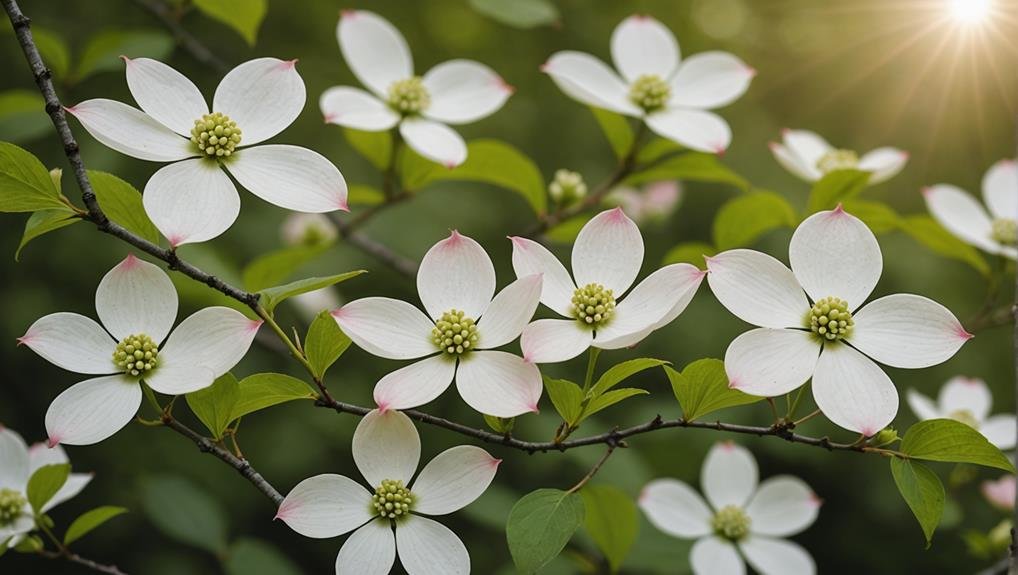
Flowering dogwood (Cornus florida) is a quintessential tree in the Southern United States, recognized for its striking white, pink, or light red blossoms. This tree holds significant cultural and botanical value, particularly in states like North Carolina and Virginia, where it is honored as the state flower and state tree, respectively. While often compared to the cherry blossom for its delicate and picturesque flowers, the dogwood carries its own unique charm and symbolism.
In the Victorian language of flowers, dogwoods are associated with faithfulness, steadfastness, durability, and endurance. These attributes make them a fitting choice for weddings, where such virtues are highly valued. The tree's blossoms can be arranged in a loose, natural style to evoke a sense of casual elegance or paired with other flowers to create more structured and sophisticated arrangements.
Beyond their use in floral arrangements, dogwood-inspired products, such as wedding stationery and flower hairpins, are popular choices for Southern weddings. The versatility of the dogwood flower assures it can complement a variety of wedding themes, from rustic to modern, making it an enduring favorite among brides and florists alike.
Physical Description
Renowned for their ornamental beauty, dogwood trees (Cornus florida) exhibit showy clusters of white, pink, or light red flowers composed of four petal-like bracts surrounding a central cluster of tiny yellow blossoms. These deciduous trees are particularly admired for their elegant and striking appearance during the flowering season. The white flowers, a popular choice for weddings, are especially noted for their pure and classic aesthetic.
In addition to their distinctive blooms, dogwood trees feature oval-shaped leaves with prominent veins and a glossy green color that shifts to a vibrant red in the fall. This seasonal color change adds to their year-round appeal.
Typically, dogwood trees grow to a height of 15-30 feet, with a spread of 15-25 feet, forming a compact and rounded canopy that provides a charming visual element in landscape designs.
Native to the eastern United States, dogwoods thrive in moist, well-drained soils and prefer partial shade conditions. Their moderate size and attractive foliage make them suitable for a variety of garden settings, enhancing both formal and informal landscapes with their understated elegance and natural beauty.
Available Colour Varieties
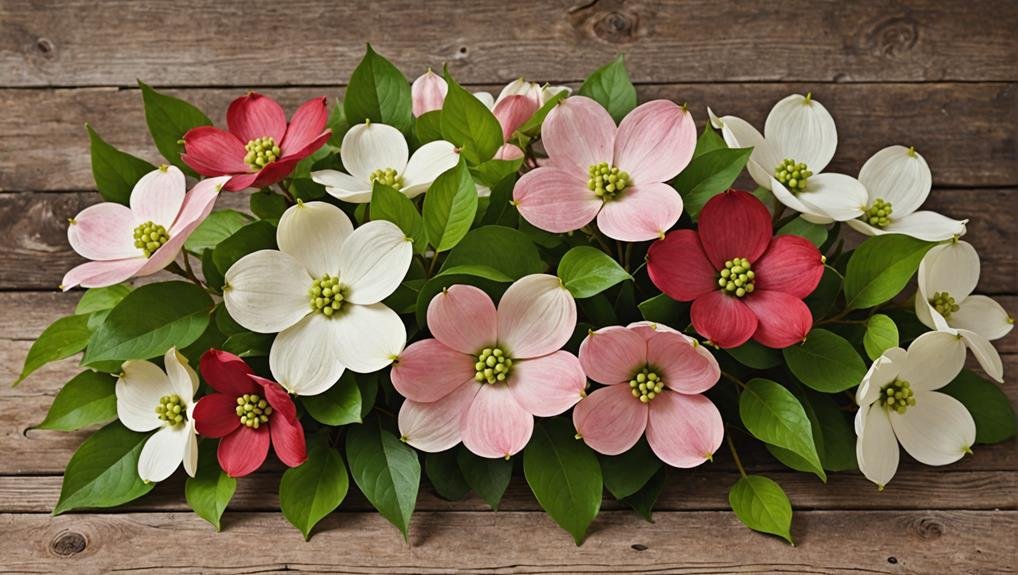
Dogwood flowers are available in a range of colors including white, pink, and light red, each bringing unique charm and versatility to wedding floral arrangements. These colors create a varied and appealing color palette that can complement any wedding theme. White dogwood flowers are the most common and symbolize purity and innocence, making them a popular choice for traditional weddings. The pink and light red varieties add a pop of vibrancy and can enhance the overall aesthetic of the decor.
In addition to solid colors, some dogwood varieties feature a mix of hues, such as white petals with pink or red accents. These mixed-color blooms add visual interest and depth to floral arrangements, providing an elegant contrast that can highlight other elements of the wedding decor. When choosing dogwood flowers, understanding the available color varieties is essential for creating a cohesive and visually appealing floral design.
| Color | Description | Symbolism |
|---|---|---|
| White | Common, symbol of purity and innocence | Traditional and timeless |
| Pink | Adds vibrancy and charm | Romance and admiration |
| Light Red | Bold and eye-catching | Passion and love |
This versatile color palette guarantees that dogwood flowers can be tailored to suit any wedding style or preference.
Latin Name and Taxonomy
The Latin title for dogwood is Cornus florida, and it belongs to the Cornaceae lineage. This deciduous tree is renowned for its vibrant spring blooms, which can be white, pink, or light red. The classification of dogwoods is quite diverse, encompassing various species and hybrids, each with distinct characteristics that contribute to their widespread appeal in both natural and landscaped settings.
Cornus florida is particularly praised for its ornamental value, making it a favored choice in wedding floral arrangements. The classification extends beyond just Cornus florida, including other notable species such as Cornus kousa and Cornus nuttallii. These species differ in their flowering periods, growth habits, and appearances, yet they all share the quintessential dogwood charm.
Understanding the Latin title and classification of dogwoods is essential for horticulturists and florists alike. Accurate identification ensures appropriate care and best use in design, especially in intricate settings like weddings. The grouping within the Cornaceae lineage highlights the evolutionary traits that make dogwoods resilient and visually enchanting.
Geographical Origins
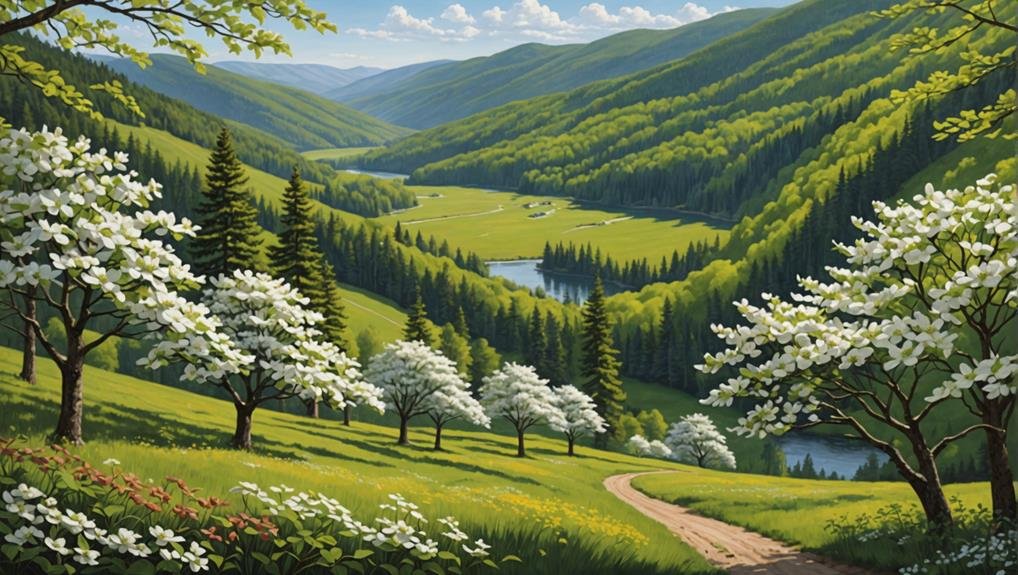
Native to eastern North America, flowering dogwood (Cornus florida) spans from southern Maine to northern Florida and extends westward to eastern Texas. This versatile tree thrives in moist, well-drained soil, commonly populating forests, woodlands, and stream banks. The Eastern United States, particularly the Appalachian region, boasts a rich diversity of dogwood species, with the flowering dogwood being a prominent feature in its natural landscape. Known for their southern blooms, these trees are popular in landscaping due to their showy flowers and attractive foliage.
Dogwoods are not only a feast for the eyes but also hold historical significance. The botanical name 'Cornus' refers to the hard wood of the tree, historically valued for woodworking and crafting purposes. This combination of aesthetic appeal and practical utility has cemented the dogwood's place in both natural and cultivated environments.
| Region | Notable Features |
|---|---|
| Southern Maine | Northernmost native range |
| Northern Florida | Southern blooms |
| Eastern Texas | Westernmost native range |
| Appalachian Region | High species diversity |
Understanding the geographical origins of the flowering dogwood enhances our appreciation for this elegant tree. Its adaptability across diverse environments underscores its suitability for various landscaping and gardening projects.
Season Availability
Understanding the seasonal availability of flowering dogwood is essential for planning landscaping and gardening projects. Dogwood trees typically bloom from early spring to late spring, with their flowering periods stretching from March to May, depending on the region.
This bloom period often coincides with the appearance of cherry blossoms, creating a visually stunning landscape.
The flowering period of dogwoods generally lasts around 2-4 weeks, though this can vary based on weather conditions and the overall health of the tree. Ideal blooming requires cool winters and mild springs, as dogwood flowers are sensitive to temperature changes.
For instance, a sudden frost or an unseasonably warm spell can greatly impact the timing and duration of their blooms.
Different species of dogwood, such as Cornus florida and Cornus kousa, may have varying bloom times and durations. This variability can be advantageous for gardeners looking to extend the flowering season in their landscapes.
Dogwoods are well-suited to USDA hardiness zones 5-9, where they thrive and are found in abundance during their blooming season. By understanding these seasonal nuances, one can better plan for the inclusion of dogwoods in gardens, ensuring a vibrant and timely display of flowers.
Growing Conditions
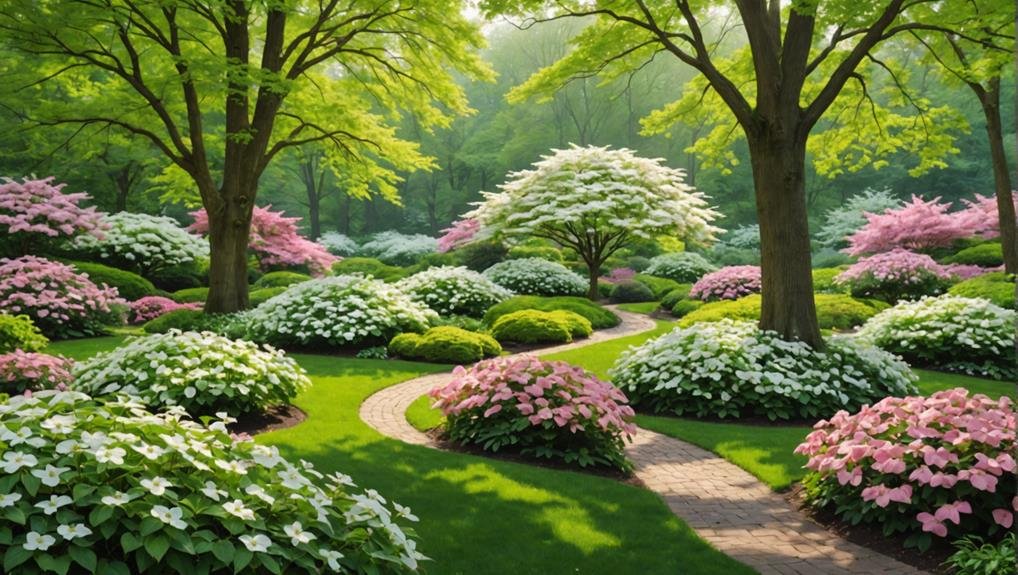
Dogwood trees require well-drained, acidic soil and benefit from partial shade to full sun exposure for best growth. These conditions ensure strong health and abundant flowering, essential for creating a stunning dogwood bouquet. Dogwoods are hardy in USDA zones 5-9, with certain varieties adapted to even colder climates. They thrive best in moist soil, necessitating regular watering, particularly during hot and dry periods. This moisture is essential for maintaining the tree's health and ensuring the vibrancy of its blooms, which are often sought after for wedding arrangements.
Proper care is crucial as dogwood trees are susceptible to diseases such as powdery mildew and anthracnose. To mitigate these risks, it is important to monitor the trees regularly for signs of disease and address any issues promptly. Additionally, pruning should be conducted in late winter to early spring. This timing promotes healthy growth and enhances the tree's flowering potential, which is particularly beneficial when cultivating dogwoods for floral displays.
Cultural Significance
Given the ideal growing conditions, dogwoods not only flourish in gardens but also hold a profound cultural significance, particularly in the context of weddings. The symbolic meanings attributed to dogwoods, such as faithfulness, durability, and endurance, resonate deeply with the themes of matrimonial ceremonies. In Victorian flower language, dogwoods epitomize loyalty and strength, further enhancing their cultural significance.
Furthermore, dogwoods are the state flower of North Carolina and Virginia, which adds a layer of sentimental value for couples marrying in these states. The cultural significance of using a flower that represents regional pride can make wedding ceremonies more meaningful and personalized.
Dogwoods also enjoy a versatile application in various aspects of wedding decor. Their aesthetic appeal and symbolic richness make them a fitting choice for floral arrangements, enhancing both traditional and contemporary wedding styles. Additionally, dogwood motifs extend beyond floral arrangements to wedding stationery and accessories, such as flower hairpins, particularly in Southern weddings where they are especially popular.
Incorporating dogwoods into wedding themes allows couples to infuse their special day with a sense of tradition, regional pride, and enduring love, making them an emblematic choice for this significant life event.
Typical Use in Weddings
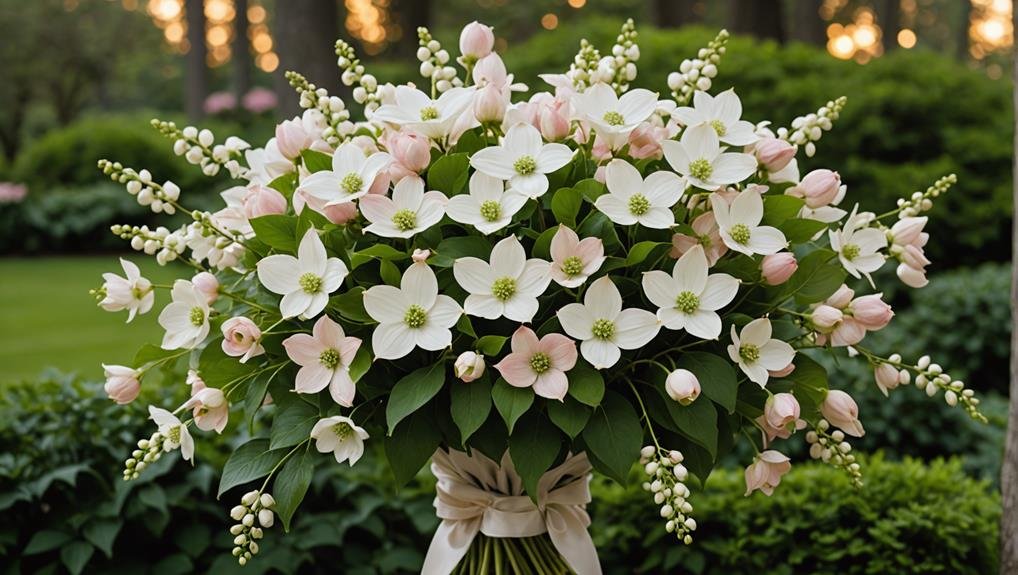
In wedding ceremonies, dogwood flowers are frequently utilized for their elegant beauty and deep symbolic meanings. Celebrated for their association with faithfulness, durability, and endurance, dogwoods are a popular choice for many couples on their wedding day. Their delicate blossoms are often arranged in loose, natural styles, which can enhance the overall aesthetic of wedding decor.
Dogwood flowers can be effectively paired with all-white blooms to create a sophisticated, monochromatic look. Alternatively, they can be mixed with wildflowers for a charming, garden-inspired arrangement. The versatility of dogwoods allows them to fit seamlessly into various wedding themes, from rustic to elegant.
Dogwood stems are particularly well-suited for bud vases or glass bottles, making them an elegant addition to table settings or bouquets. Additionally, their distinctive branches and clustered blooms can be creatively incorporated into wedding cakes, adding a unique and natural touch to the culinary presentation.
| Use in Weddings | Style | Pairings |
|---|---|---|
| Table Settings | Bud vases or glass bottles | All-white blooms or wildflowers |
| Bouquets | Loose, natural arrangements | Monochromatic or garden-inspired |
| Wedding Cakes | Decorative branches and clustered blooms | Enhancing floral-themed designs |
Whether showcased in bouquets, table centerpieces, or even on wedding cakes, dogwood flowers offer a timeless and versatile option for any wedding day.
Alternative Flower Types
While dogwood flowers are a timeless choice for weddings, other flower types such as peonies, roses, hydrangeas, and lilies also offer unique beauty and symbolism for bridal arrangements.
Peonies are particularly cherished for their lush, full blooms and are often chosen for their symbolism of prosperity and romance. Their soft, elegant petals can add a touch of timeless beauty to any bouquet.
Roses, known for their classic appeal, come in a variety of colors, each carrying its own unique meaning. Red roses symbolize deep love and passion, while white roses stand for purity and new beginnings, making them a versatile option for wedding arrangements.
Hydrangeas, with their voluminous clusters of flowers, represent heartfelt emotions and gratitude. They are perfect for creating a soft, romantic ambiance and can be used to complement other flowers in the bouquet or as standalone arrangements.
Lilies, admired for their striking appearance and pleasant fragrance, embody purity and devotion. Often used in wedding bouquets, lilies add a dramatic flair and are available in various colors to match any wedding theme.
Each of these alternative flowers brings its own distinct charm, ensuring a memorable and beautiful bridal arrangement.
